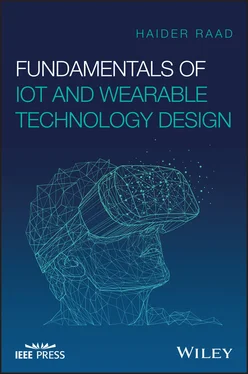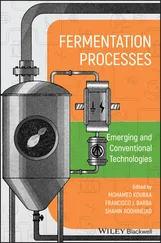One specific privacy concern associated with the emerging smart glasses is that they allow users to simultaneously record and share images and videos of people and their activities in their range of vision, in real time. This problem will soon be intensified when such devices are integrated with facial recognition programs which will allow users to see the person's name in the field of view, personal information, and even visit their social media accounts.
1.1.5.3 Standards and Regulations
The lack of standards and best practices documentations poses a major limitation to the potential of IoT and wearable devices. Without standards to guide manufacturers and developers, these products that often operate in a disruptive manner would lead to interoperability issues and might have negative impacts if poorly designed and configured. Such devices can have adverse consequences on the network resources they connect to and the broader Internet. Unfortunately, most of this comes down to cost constraints and the pressuring need to release a product to the market quicker than competitors. Moreover, there is a wide range of regulatory and legal questions surrounding the IoT and wearable technology, which require thoughtful consideration.
Legal issues with IoT and wearable devices may include conflicts between governmental surveillance and civil rights; policies of data retention and destruction; legal liability/penalty for unintended uses; and security breaches or privacy abuses. Furthermore, technology is advancing much faster than the associated policy and regulatory environments which might render policies and regulations to be inappropriate.
Big data presents another serious challenge. The analysis, extraction, manipulation, storage, and processing of substantial amounts of data may pose other legal problems as in profiling, behavior analysis, and monitoring. Big data may require new protection policies, international coordination, and infrastructure management, among others.
Furthermore, the cloud and even the Internet itself are not tied to one specific geographic location. Moreover, the sheer amount of IoT and wearable devices originate from a number of different sources, including international partners and vendors, which makes it impossible for a localized regulatory authority to enforce quality control or standardized tests.
As yet, these challenges have been minimally acted upon by policy makers. However, they reflect a pressing necessity to seek government solutions to both pronounce the strengths of these technologies and deploy policies to minimize their risks.
1.1.5.4 Energy and Power Issues
The increase in data rates and the number of Internet‐enabled services and the exponential growth of IoT and wearable devices are leading to a substantial increase in network energy consumption.
Moreover, the push toward smaller size and lower power is creating more signal and power integrity problems in IoT and wearable devices. Common issues include mutual coupling, distortion, excessive losses, impedance mismatch, and generator noise. Failure to deal with these issues can have detrimental effects on these devices.
According to recent research reports, around 22 billion IoT and wearable devices will be connected to the Internet by 2020. Thus, it is just a matter of time before users begin to experience substantial bottlenecks in IoT connectivity, proficiency, and overall performance.
Currently, a big percentage of connected devices rely on centralized and server/client platforms to authenticate, authorize, and connect additional nodes in a given network. This model is sufficient for now, but as additional billions of devices join the network, such platforms will turn into a bottleneck. Such systems will require improved cloud servers that can handle such large amounts of information traffic. This is already being addressed by the academic and industrial community which is pushing toward decentralized networks. With such networks, some of the tasks are moved to the edge, such as using fog computing, which takes charge of time‐sensitive operations (this will be discussed in detail in chapter 7), whereas cloud servers take on data assembly and analytical responsibilities.
IoT and wearable devices are enabled by the latest developments in smart sensors, embedded systems, and communication technologies and protocols. The fundamental premise is to have sensors and actuators work autonomously without human involvement to deliver a new class of applications. The recent technological revolution gave rise to the first phase of the IoT and wearable devices, and in the next few years, these devices are expected to bridge diverse technologies to enable novel applications by connecting physical objects together in favor of intelligent decision making.
Benefits are substantial, but so are the challenges. This will require businesses, governments, standards bodies, and academia to work together toward a common goal.
In short, IoT and wearable technology are representative icons of the most recent industrial revolution. Given that we advance and evolve by transforming data into information, knowledge, then into wisdom, these technologies have the potential to change the world as we know it today, in new and exciting ways.
1 What are the main differences between IoT and wearable technology?
2 What is it meant by “things” in Internet of Things?
3 What are the main differences between IoT and M2M?
4 Can you think of other potential challenges found in IoT and wearable technology other than the ones mentioned in this chapter?
5 Give examples of wearable devices/applications that do not require Internet connectivity.
6 List five real‐world examples of smart clothing.
7 List five real‐world examples of the headwear form in wearable technology.
8 List four components common between IoT and wearable devices (an application of your choice).
9 Are wearable devices a form of M2M? Why?
10 If you are asked to add more somewhat essential characteristics to IoT, what would they be? Why?
1 In simple words, explain the term IoT.
2 Who are the key players in the field of IoT?
3 Who are the key players in the field of wearable technology?
4 What is M2M? Where does IoT intersect with M2M?
5 How is wearable technology expected to have an impact on our daily life?
6 How is 5G technology going to affect the deployment of IoT?
7 What will happen in terms of jobs losses and required skills as IoT makes devices more intelligent?
8 How would wearable technology affect businesses?
9 What is the difference between the “Things” in “Internet of Things” and sensors?
10 What is the connection of IoT to Big Data?
1 Aazam, M. and Huh, E.‐N. (2014). Fog computing and smart gateway based communication for cloud of things. Proceedings of the 2nd IEEE International Conference on Future Internet of Things and Cloud (FiCloud '14), Barcelona, Spain (August 2014), pp. 464–470.
2 Atzori, L., Iera, A., and Morabito, G. (2011). SIoT: giving a social structure to the Internet of Things. IEEE Communications Letters 15 (11): 1193–1195.
3 Bertolucci, J. (2010). Reliability report card: grading tech's biggest brands. PC World 27 (2): 82–92. Chan, J. November 4.
4 Erfinder, A., Engebretson, A.M., Morley, R.E. Jr., and Popelka, G.R. (1984). Hearing aids, signal supplying apparatus, systems for compensating hearing deficiencies, and methods. US Patent 4548082.
5 Guo, B., Zhang, D., Wang, Z. et al. (2013). Opportunistic IoT: exploring the harmonious interaction between human and the internet of things. Journal of Network and Computer Applications 36 (6): 1531–1539.
Читать дальше












